Chanting nature in a stone forest, hooking history from a rural road
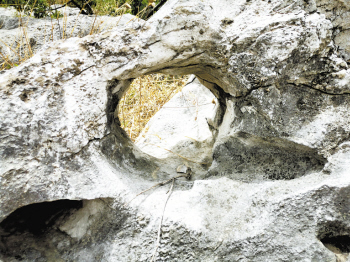
The "Fairy Bridge" formed by the cave
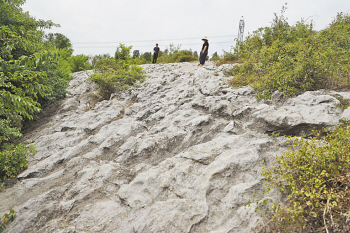
The largest stone in the stone forest
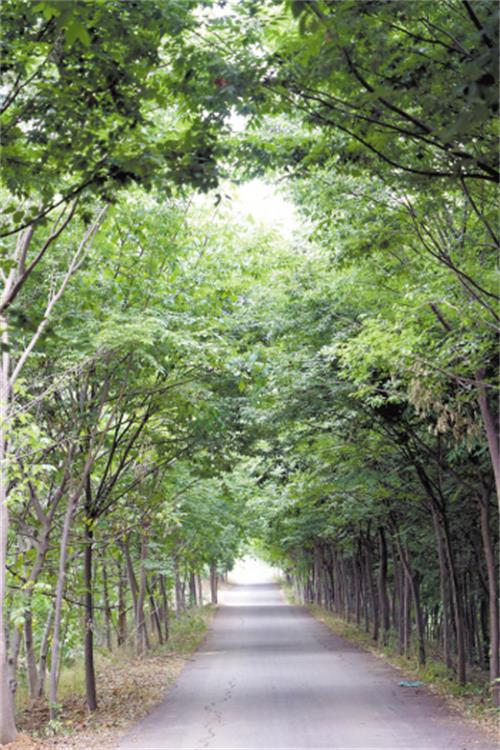
This shady path at the foot of Changshan Mountain was once walked by Zhang Boying 120 years ago
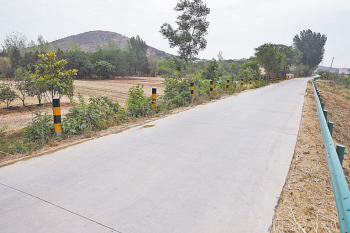
What used to be a railway is now a cement road
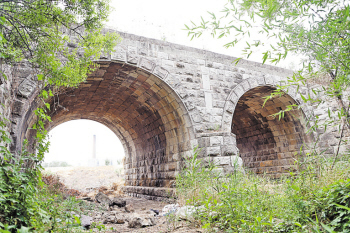
The double-arch stone bridge built during the Anti-Japanese War is still intact
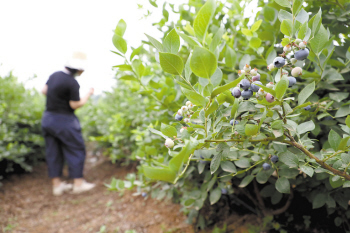
blueberries are ripe
Editor's note:
Who says familiar places don't have scenery? Yi'an Mountain Karst Cave, Wushao Stone Village, Yinshan Rift Valley... Have you been to Xuzhou? With the help of the "One-Hour Traffic Circle", this column launches the "One-Hour Scenic Circle" to introduce a group of little-known, wild and culturally-recognized niche scenic spots. Let's travel through Xuzhou's landscapes and see the scenic beauty of Pengcheng!
Text / reporter Wu Yun
Picture video / reporter Zhou Jie
In the hot summer, the visiting team of Xu Bao's "Reading City Secret Realm" came to the mountains in the southwest of Xuzhou, where the eyes were green and refreshing. On the Changshan Mountain, which stretches for about 9 miles, there is the largest primitive stone forest in Xuzhou. It is said that Zhang Boying, a calligrapher in the late Qing Dynasty and early Republic of China, once passed by here. There is an old railway subgrade more than ten kilometers long at the foot of the mountain, which is a civil engineering built during the Anti-Japanese War.
●A shocking stone forest
On the morning of June 12, under the leadership of Yu Kenan, a scholar of literature and history, the visiting team went all the way from Daxue Road to the south, and a striking "Zhang Boying Art Museum" road sign appeared in front of us, as if we knew that we were going to visit this master. "God crossing" through time and space.
Along Fuli Avenue, cross Lianhuo Expressway to Tongtai Line, turn west, and pass a village called Barracks. The houses on both sides of the road have white walls and black tiles, and the villagers are relaxed and comfortable. The long mountain covered with beech, elm and cypress quickly came into view, and the green color was so thick that we immediately forgot the heat and noise of summer.
"This mountain was called Changshan before the Qing Dynasty, and it was recorded as Changshan in the "Tongshan County Chronicle" of the Republic of China. It is indeed very long, and the mountain is 9 miles long."
As we climbed up the mountain, we listened to Yu Kenan's introduction to the history of Changshan.
Although Changshan is very long, it is only a few dozen meters above sea level. We soon found the stone forest. On the hillside, there are large and small cyan rocks everywhere, with all kinds of strange shapes. The fat and white "sheep", the happy "pony", the cute and cute "whale", all of them have round "big". Eye". Some strange rocks are more than half a meter high, looking down like a cliff. Between the stones, unknown plants grow tenaciously.
There is a hole in a strange stone. In the world of stone appreciation, stones with holes are always favored. In the Changshan Stone Forest, almost every stone has a hole, some of which are round and deep, like ignorant big eyes looking at tourists curiously; There are several big holes in succession, just like the paw prints left by the giant bear, which makes people sigh "Beautiful Zhong Shenxiu".
The largest boulder is 100 meters long, with ravines, ravines, and spots on it, like the wrinkles on the face of the vicissitudes of life, and the wrinkles produced by the perennial beating of the sea, telling the story of the vicissitudes of life and the passage of time.
Yu Kenan said that he has visited this stone forest many times, and every time he feels very shocked. He has traveled all over the mountains and peaks of Xuzhou. This stone forest is the largest, with a length of more than 400 meters from north to south.
●An unforgettable history
The unknown Changshan is visited by few people. At the foot of the mountain, there is a quiet path leading to Xiaoxian County, Anhui Province. The sides of the three- or four-meter-wide road are planted with elm trees. The breeze is coming, and the birds are chirping.
A quiet and peaceful country road has witnessed the crimes of the Japanese army during the occupation of Xuzhou. Older local villagers know that after the Japanese army occupied Xuzhou in 1938, they occupied Gushan Coal Mine and built a railway from Gushan Coal Mine to Sanbao to transport coal.
Yu Kenan checked the information and learned that the railway is about 12 kilometers long. It started construction in 1938 and was completed in 1939. It connects Sanbao Railway Station in the east and Gushan Coal Mine in Xiaoxian County in the west. It is a powerful testimony to the Japanese looting Xuzhou coal. The roadbed is about 6 meters high, you can see, there are dozens of ponds on both sides of the road, all of which were formed by digging soil to build the roadbed back then.”
There is a culvert under the roadbed near the barracks village, which is the place for pedestrians to pass during the use of the railway. A 60-year-old villager surnamed Song in Yingfang Village said that he had heard from a young age that this place used to be a railway, which was built by the Japanese hired villagers to transport coal.
Gushan now belongs to Xiaoxian County, Anhui Province. Going along this road to Gushan, you can find a beautiful and sturdy double-arch stone bridge under the roadbed on the west side of Baihu Mountain Village. On the two stone tablets inlaid on the bridge, the words "Qingbo Bridge", "Gushan Coal Mine Manager", "Designer" and "Performer" are clearly written, and the inscriptions have three Japanese names. After more than 80 years of wind and rain, the stone bridge is still intact, and no one has fallen off or deformed.
Villagers working in the fields by the bridge said that they had heard when they were children that the bridge was built by the Japanese.
Yu Kenan found an old black-and-white photo from his mobile phone. It was a group of ordinary people hired by the Japanese who carried tools and walked by the railway. The villager said: "I have to take a picture and let the villagers see it."
In the 1950s, on this railway, the trains were still running normally, carrying both goods and people. The fare for passengers was 5 cents. turned into a flat concrete road.
●The scenery of the quiet time all the way
Brushing off the dust of history, 120 years ago, Zhang Boying, a calligrapher in the late Qing Dynasty and early Republic of China, once walked on this road at the foot of Changshan Mountain.
Yu Kenan read "Xuzhou Continuing Poems" and found that Zhang Boying's cousin Zhang Weirui once recorded in the poem "Shaopu Brother Yo and Zhemin's Four Uncles Traveling to Xishan" that on the Double Ninth Festival in 1902, Zhang Boying lived in Yuzhuang, Tongshan. (that is, being admitted to the imperial examination), pass this road to worship Zulin. The poem wrote: "Chongyang is a windy day, but the autumn of Renyin. Nancun Yanzhe old man, with a tour of the West Mountains. Going out along the waterfront, the Guoguo is clear and shallow. Winding around the Tashan, Jiaxiang bamboo trees are quiet." It is the word of Zhang Boying, and Xishan refers to several hills west of Yuzhuang, including Tashan and Changshan.
The charming scenery in the poem can be vaguely followed now. The Changshan Mountain is surrounded by thick green, and there is still a "guoguoqing shallow stream" in the pond at the foot of the mountain. Several exquisite wooden houses are hidden among the green. This is a well-developed farmhouse where you can fish, pick and relax. The boss has planted beech trees all over the mountain, some young trees are just beginning to grow, and some are already covered in shade. When the blueberries are ripe, they all grow freely in the open air. Strings of fruits are blue and black, crystal clear and lovely. Pick one and put it in your mouth.
The wheat fields at the foot of the mountain have just been harvested, and it is another harvest year. Some farmers are busy planting strawberries, and the nearby Taishang Village is a famous strawberry town.
The green hills are faint, the running water is long, the green trees are shady, and the scenery is picturesque. May this tranquility and beauty remain in the world.
▲Travel strategy
1. It is located on the south side of Yingfang Village, Tongshan District Sub-district Office. You can navigate Xiaolao Mountain Pass, turn right after reaching Xiaolao Mountain Pass, go 300 meters ahead, and there is a public toilet at the end.
2. Start climbing the mountain from the west side of the public toilet, and you will soon reach the stone forest.
3. The stone forest is relatively primitive, there are no roads to follow, and there are many thorns. It is recommended to wear long sleeves, trousers, and travel shoes when visiting, and pay attention to safety.
4. The double-arch stone bridge is located on the road from Xiaolaoshan Pass to Gushan, in Baihu Mountain Village. It is relatively hidden, and you can ask the villagers.